Wildlife crime in Scotland: 2015 annual report
The fourth wildlife crime annual report, this highlights new data from the financial year 2014 to 2015.
4. Wildlife Crime Priority Areas
Wildlife crime priorities are set at UK level by the Wildlife Crime Tasking and Co-ordinating Group. The group's membership includes the Police, the Partnership for Action against Wildlife Crime ( PAW), National Wildlife Crime Unit ( NWCU), and the Joint Nature Conservation Committee ( JNCC).
The priorities remained unchanged in 2014-15:
- Badger persecution
- Bat persecution
- Convention on International Trade in Endangered Species of Wild Fauna and Flora ( CITES)
- Freshwater pearl mussels
- Poaching (including deer poaching, hare coursing, fish poaching)
- Raptor persecution.
Priority groups on poaching and coursing, and freshwater pearl mussel crime, continue to operate in Scotland, as well as the PAW Scotland Raptor Group (formerly the Raptor Persecution Priority Delivery Group).
The following sections provide more detail on each of these priority areas, along with the relevant data. The additional sections from the 2014 report on the Protection of Wild Mammals (Scotland) Act 2002 and Trapping and Snaring continue to be included.
4.1 New Police Scotland Disaggregated Data
Recommendations made by the previous Rural Affairs, Climate Change and Environment Committee on improving the data presented in the annual report continue to be built on. In this report, Police Scotland have provided a manual disaggregation of wildlife crime reports and these have now taken the place of data supplied by partner organisations. This data is shown in Figure 1 and
Table 15.
In order to assist the reader, the graphs in this section have been presented in a different format so that it is both easy to understand but importantly, to avoid attempts to compare different data sets provided from different sources. The provision of data by Police Scotland has been resource intensive and there will be further consideration of how to simplify this going forward.
Unfortunately it has not been possible to present the data for each of the 6 priority areas, plus the two additional sections on the Protection of Wild Mammals (Scotland) Act 2002 and Trapping and Snaring, in a quarterly format.
Data in Table 1 is sourced from the Scottish Government Recorded Crime figures and care should be taken in comparing those figures with the disaggregated figures provided in this section.
The work done by Police Scotland to disaggregate the data was commenced several months after the data for the official Scottish Government Recorded Crime statistics was produced. During the time between the generation of the official statistics and the completion of the disaggregated data results, some crimes may have been 'no-crimed', or reclassified resulting in an observed difference in the crime totals.
Going forward for future reports, this should be less of an issue as the data used to disaggregate the crimes will have been generated at the same time as the official recorded statistics and therefore the totals should be more closely aligned.
Figure 1: Police Scotland Disaggregated Offence Data from 2013-2015
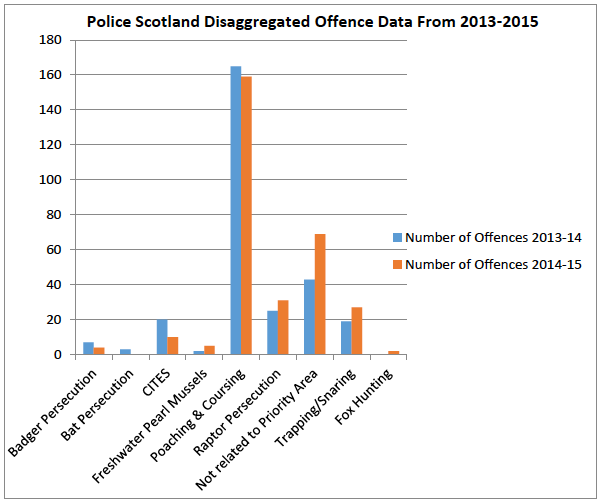
Source: Police Scotland
Table 16: Police Scotland Disaggregated Offence Data from 2013-2015
| Wildlife Crime Priority etc. |
Number of Offences |
|
|---|---|---|
| 2013-14 |
2014-15 |
|
| Badger Persecution |
7 |
4 |
| Bat Persecution |
3 |
0 |
| CITES |
20 |
10 |
| Freshwater Pearl Mussels |
2 |
5 |
| Poaching & Coursing |
165 |
159 |
| Raptor Persecution |
25 |
31 |
| Not related to Priority Area |
43 |
69 |
| Trapping/Snaring |
19 |
27 |
| Fox Hunting |
0 |
2 |
| Total |
284 |
307 |
Source: Police Scotland
4.2 Badger Persecution
All badgers in Scotland are protected by law, but they are sometimes still illegally targeted by those who see them as a pest or for the purposes of illegal animal fights.
Recorded crimes
Table 15 shows that there were four offences relating to badger persecution recorded by Police Scotland in 2014-15, compared to seven in 2013-14. Table 16 provides a further breakdown of the 2014-15 crimes. Figure 2 shows the data as a bar chart for ease.
Figure 2: Police Scotland Disaggregated Offence Data For Badger Persecution
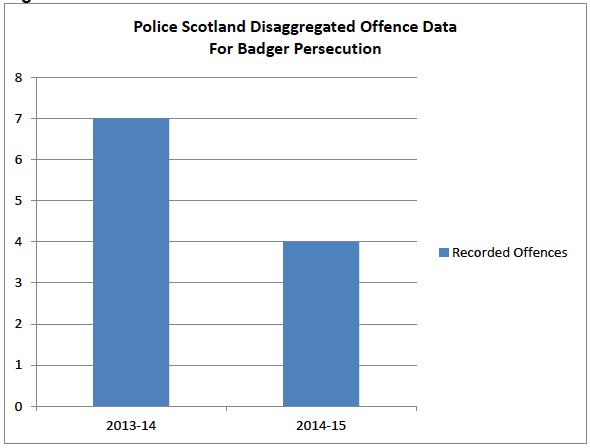
Source: Police Scotland
Table 17: Summary of 2014-15 badger persecution crimes
| Police Division |
Type of Crime |
Date |
|---|---|---|
| Forth Valley |
Sett damage/destruction |
May 2014 |
| Fife |
Snaring |
May 2014 |
| Lothians and Scottish Borders |
Sett damage/destruction |
September 2014 |
| Fife |
Sett blocking |
February 2015 |
Source: Recorded Crime in Scotland
4.3 Bat Persecution
Bats and their roosts are protected by the Conservation (Natural Habitats, &c.) Regulations 1994), which gives strict legal protection to all species listed under Annex IV of the EU Habitats Directive - known as European Protected Species ( EPS). Scotland's bat population is relatively small compared to other parts of the UK.
Recorded crimes
Table 15 and Figure 3 show that there were three offences recorded by Police Scotland in 2013-14, related to three separate incidents. Two of these involved the illegal blocking up of bat roosts, while the other involved the destruction of a tree which was being used a bat roost.
There were no offences involving bat persecution recorded by Police Scotland in 2014-15. As with all types of wildlife crime, it is entirely possible that some offences were committed, but went unreported. Even one offence can have a significant effect on a local bat population and it is vital that any suspicious activity around bat roosts is reported to the police.
Figure 3: Police Scotland Disaggregated Offence Data For Bat Persecution
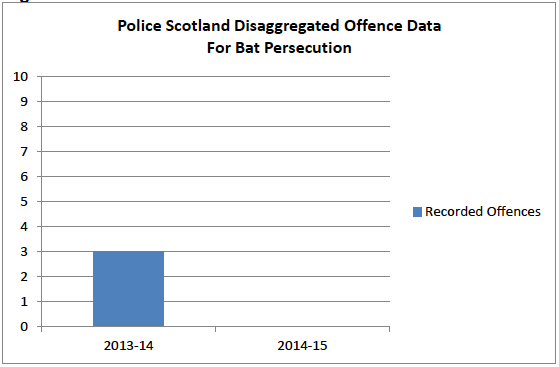
Source: Police Scotland
4.4 CITES
CITES is the Convention on International Trade in Endangered Species of Wild Fauna and Flora. It is an international agreement between governments, which aims to protect certain animal and plant species from over-exploitation by trade.
In Scotland and the rest of the UK, this agreement is given legal authority by the Control of Trade in Endangered Species (Enforcement) Regulations 1997, known as COTES.
Recorded Crimes
Table 15 and Figure 4 show that 10 CITES-related offences were recorded by Police Scotland in 2014-15, compared to 20 in 2013-14. These 10 offences all related to a single incident, involving the keeping and commercial display of a number of endangered species in Fife. These included wild cats, lemurs, birds of prey and tortoises.
Figure 4: Police Scotland Disaggregated Offence Data For CITES
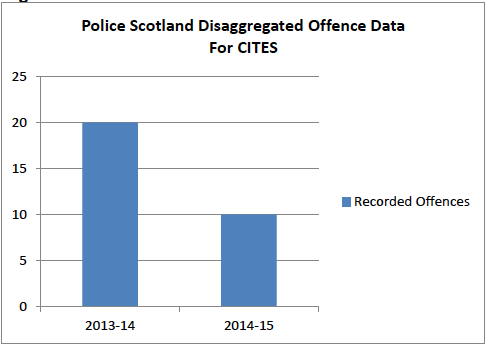
Source: Police Scotland
Police Scotland expect the numbers of recorded offences to increase in future years, due to increased public awareness and reporting of illegal wildlife trading, particularly online.
4.5 Freshwater Pearl Mussels
Scotland supports several of the largest remaining populations of freshwater pearl mussels ( FWPM) in the world which, unfortunately, continue to be damaged by criminal activity. Pearl fishing continues in Scotland, almost uniquely within Europe. FWPM are also threatened by criminal damage by unlawful river engineering and pollution events.
The overall objective of the FWPM priority delivery group is to raise awareness of the threat posed by criminality and help communities in hotspots to prevent criminality and identify offenders.
Recorded crimes
During 2014-15, 5 offences were recorded by Police Scotland. Table 15 and Figure 5 show the numbers of recorded crimes and incidents for the period 2013-14 to 2014-15.
Figure 5: Police Scotland Disaggregated Offence Data For Freshwater Pearl Mussels
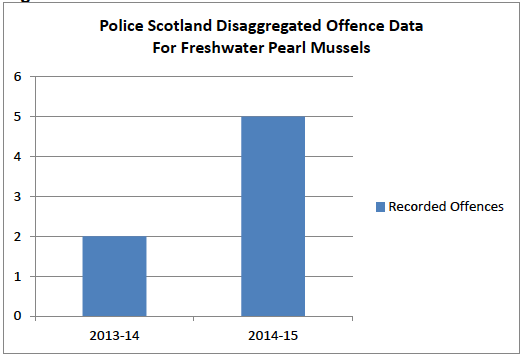
Source: Police Scotland
The FWPM delivery group continued to be active in 2015. To further increase awareness of FWPM, Riverwatch schemes were launched on the River South Esk, the River Moriston, in Lochaber and in north Sutherland. These schemes were to help local communities detect suspicious activity in their local rivers and encourage them to report it to the local police. These schemes represent the culmination of three years of work across many rivers as part of the Pearls in Peril LIFE+ project, and all received a good reception locally and in the media.
Training was also provided to local rangers staff, trainee fishery bailiffs and wildlife crime officers to continue improving awareness of the species and the threats that criminality poses to its conservation. The second national survey of the species in Scotland was also published in 2015 by Scottish Natural Heritage. The survey unfortunately confirmed that criminality remains a key threat to pearl mussels and, alongside water quality, has helped the targeting of action to key sites to help conserve the species. During 2015 pro-active, intelligence-led operations by Police Scotland also took place at key sites to help reduce the threat posed by wildlife crime. Since the national survey was completed, more regular monitoring of key vulnerable populations has taken place to help improve the detection of any potential crimes and support any future prosecutions. Ongoing investigations are also continuing following alleged pollution incidents that damaged local pearl mussel populations.
In December 2015 the first FWPM hotspot maps were published showing hotspots of incidents where crime has affected freshwater pearl mussels showing crimes over the 5 year period 2010-14.
4.6 Poaching and Coursing
Poaching involves the taking of deer, fish or other game without permission, or using unlawful methods. Coursing is the hunting of animals with dogs. This section lays out the new Police Scotland disaggregated data in addition to providing an overview on the work of the Poaching & Coursing Delivery Group.
Recorded crimes
During 2014-15, 159 poaching and coursing offences were recorded by Police Scotland data. This was a small decrease from 2013-14 which was 165. Table 15 and Figure 6 show the numbers of recorded crimes for the period 2013-14 to 2014-15.
Figure 6: Police Scotland Disaggregated Offence Data For Poaching and Coursing
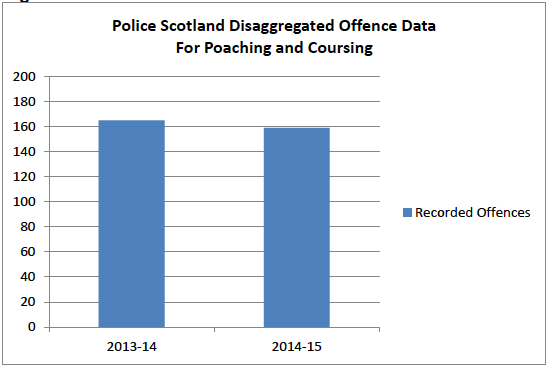
Source: Police Scotland
Some offences under this category were outdated and no longer applicable, while others are now covered by different legislation, such as the Wildlife and Countryside Act 1981 and may be included in other categories. Unfortunately this means it is not currently possible to disaggregate certain poaching related offences. Additionally, the new disaggregated data supplied by Police Scotland for poaching and coursing does not differentiate between species (fish, deer etc) and the further break down of these figures will be considered for future reports.
As highlighted in Chapter 2, fish poaching related offences were the most common type of wildlife crimes both recorded by Police Scotland and taken forward for prosecution by COPFS in 2014-15.
The Poaching and Delivery Group continued its activities under a new chair of the who was appointed in 2015. The group objectives were reconsidered which resulted in a new action plan being created based around intelligence, prevention and enforcement strategies.
A number of items of work were carried out in 2015 including:
- A seasonality chart identifying times when poaching was most prevalent was created to assist enforcement efforts.
- A recording notebook designed to collate evidence for witnesses to poaching offences was created, launched and distributed.
- Training with regard to identifying, recording and attending wildlife crime incidents was provided to Police Scotland Control Rooms and Service Centre.
4.7 Raptor Persecution
Raptor, or bird of prey, persecution is the most high profile type of wildlife crime in Scotland and it can have serious impacts on the populations of some bird of prey species at local, regional or (if carried out more widely) national level.
This section lays out the new Police Scotland disaggregated data and the SASA poisoning figures in addition to providing some commentary on the work of the PAW Scotland Raptor Group.
Recorded crimes
During 2014-15, 31 offences were recorded by Police Scotland data, and increase from 25 the previous year. Table 15 and Figure 7 show the numbers of recorded crimes for the period 2013-14 to 2014-15.
Figure 7: Police Scotland Disaggregated Offence Data For Raptor Persecution
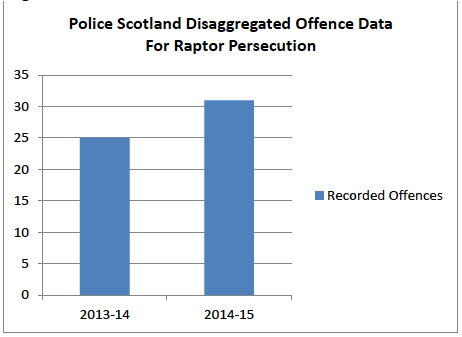
Source: Police Scotland
Poisonings and other recorded crimes
Table 17 shows the numbers of birds of prey confirmed by SASA as illegally poisoned between 2010-11 and 2014-15, alongside the number of incidents which resulted in these poisonings. The figures show that buzzards (30) were the most commonly recorded victim of illegal poisoning over the five year period, followed by red kites (26) and golden eagles (7).
Table 18: Bird of Prey Poisonings, Scotland, 2010-11 to 2014-15
| Year |
Number of Birds of Prey Poisoned (By Species) |
Number of Incidents |
||||||
|---|---|---|---|---|---|---|---|---|
| Buzzard |
Red kite |
Golden eagle |
Peregrine falcon |
Sparrow-hawk |
White-tailed eagle |
All |
||
| 2010-11 |
14 |
7 |
5 |
4 |
1 |
1 |
32 |
24 |
| 2011-12 |
3 |
3 |
1 |
2 |
9 |
6 |
||
| 2012-13 |
3 |
1 |
4 |
4 |
||||
| 2013-14 |
7 |
12 |
1 |
1 |
21 |
6 |
||
| 2014-15 |
3 |
3 |
1 |
7 |
6 |
|||
| Total |
30 |
26 |
7 |
6 |
3 |
1 |
73 |
46 |
Source: Science and Advice for Scottish Agriculture ( SASA)
Data for financial year period 1 April 2010-31 March 2015
The number of poisoning incidents over the most recent four years has remained relatively low compared to the high of 24 in 2010-11. However, illegal poisoning still has the capacity to kill high numbers of birds. For example, the large discrepancy in 2013-14 between the numbers of birds poisoned (21) and the number of incidents (6) was due to a single mass poisoning incident in Ross-shire, where 12 red kites and 4 buzzards were confirmed to have been killed with an illegal pesticide.
Figure 8: Bird of Prey Poisonings 2010-11 to 2014-15
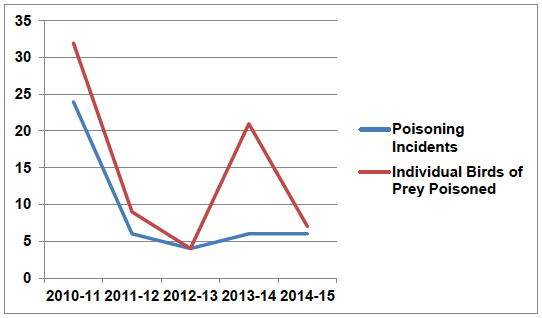
Source: SASA
Tables 18a and 18b show a summary of all recorded crimes against birds of prey in Scotland in 2013-14 and 2014-15. As with the poisoning data, these figures show that the buzzard (involved in 15 of the 37 incidents) was the species most commonly affected. There were more confirmed incidents of shooting (16) during this two-year period than poisoning (12).
Financial year data for wider bird of prey crime is currently only available from 2013-14 onwards. This dataset will be added to each year until it is possible to show a rolling five-year summary as with other data sources in this report.
Table 18a: Recorded Bird of Prey Crimes in Scotland, 2013-14 to 2014-15 by Species Involved
| Number of Incidents (by species involved) |
|||||||||||
|---|---|---|---|---|---|---|---|---|---|---|---|
| Buzzard |
Hen Harrier |
Peregrine |
Red Kite |
Golden Eagle |
Goshawk |
Osprey |
Red Kite & Buzzard |
Tawny Owl |
Unknown |
Total |
|
| 2013-14 |
8 |
2 |
2 |
2 |
1 |
1 |
1 |
1 |
1 |
0 |
19 |
| 2014-15 |
6 |
1 |
3 |
4 |
1 |
1 |
0 |
0 |
1 |
1 |
18 |
| Total |
14 |
3 |
5 |
6 |
2 |
2 |
1 |
1 |
2 |
1 |
37 |
Source: Police Scotland
The number of recorded crimes does not equate to the number of individual birds affected, as some of the incidents involved more than one bird.
Table 18b: Recorded Bird of Prey Crimes in Scotland, 2013-14 to 2014-15 by Type of Crime
| Number of Incidents (by type of crime) |
||||||
|---|---|---|---|---|---|---|
| Shooting |
Poisoning |
Trapping |
Disturbance |
Other |
Total |
|
| 2013-14 |
8 |
6 |
3 |
2 |
0 |
19 |
| 2014-15 |
8 |
6 |
1 |
1 |
2 |
18 |
| Total |
16 |
12 |
4 |
3 |
2 |
37 |
Table 19 provides further details on each of the 2014-15 recorded bird of prey crimes.
The Raptor Group continued to consider prevention, intelligence and enforcement issues regarding the persecution of birds of prey. The group met quarterly and all partners are required to brief the group in respect of ongoing work that they are involved in to tackle issues of raptor persecution.
In 2015 this included the creation of the annual bird of prey persecution maps and the ongoing work on the Hen Harrier Action Plan.
The Heads Up for Harriers project continued to be the largest piece of work for the group. This aim of the project being to understand more about the distribution of hen harriers and why nests fail.
Members of the public continued to provide sightings, and several estates agreed to have cameras installed on hen harrier nests in their grounds. In 2015, there were five upland estates involved and they recorded some notable successes, with a total of ten young birds fledging from three successful nests. A further three nests failed, two as a result of bad weather and another due to fox predation.
Table 19: Details of Recorded Bird of Prey Crimes in Scotland 2014-15
| Species |
Police Division |
Type of Crime |
Date |
|---|---|---|---|
| Buzzard |
Dumfries and Galloway |
Other (taking a bird) |
April 2014 |
| Peregrine |
Forth Valley |
Shooting |
April 2014 |
| Buzzard |
Fife |
Poisoning |
April 2014 |
| Goshawk |
Aberdeenshire and Moray |
Other (attempt to disturb and kill a bird) |
May 2014 |
| Hen Harrier |
Ayrshire |
Shooting |
May 2014 |
| Buzzard |
Forth Valley |
Shooting |
June 2014 |
| Golden Eagle |
Argyll and West Dunbartonshire |
Disturbance |
June 2014 |
| Red Kite |
Highlands and Islands |
Shooting |
July 2014 |
| Red Kite |
Forth Valley |
Poisoning |
July 2014 |
| Peregrine |
Lothians and Scottish Borders |
Shooting |
September 2014 |
| Unknown |
Lothians and Scottish Borders |
Trapping (attempted) |
September 2014 |
| Red Kite |
Highlands and Islands |
Poisoning |
September 2014 |
| Buzzard |
Tayside |
Shooting |
October 2014 |
| Buzzard |
Lothians and Scottish Borders |
Shooting |
October 2014 |
| Tawny Owl |
Lothians and Scottish Borders |
Shooting |
December 2014 |
| Peregrine |
Forth Valley |
Poisoning |
January 2015 |
| Red Kite |
Tayside |
Poisoning |
January 2015 |
| Buzzard |
Tayside |
Poisoning |
March 2015 |
Source: Police Scotland
Additionally, a dedicated phone and e-mail address were created, which has led to the recording of over 100 sightings received from the public, including seven previously unknown active pairs or nests.
4.8 Fox Hunting and the Protection of Wild Mammals (Scotland) Act 2002
This section highlight offences under the Protection of Wild Mammals (Scotland) Act 2002. Section 1 of the 2002 Act prohibits the deliberate hunting of a wild mammal with a dog. COPFS report that it is most commonly used in connection with hare coursing, although it has also been used for incidents relating to foxes, deer and badgers. It does not prohibit the hunting of rabbits by dogs.
Recorded Crime
The recorded crime statistics in Table 1 and Figure 9 show the figures for the five year period 2010-11 to 2014-15. Table 2 shows that in 2014-15, most of these offences were recorded in the Aberdeenshire and Moray Police Scotland division.
Figure 9 below shows that from the now disaggregated data from Police Scotland, 2 of the 20 hunting with dogs cases related to fox hunting offences, rather than activities such as hare coursing.
Figure 9: Police Scotland Disaggregated Offence Data For Fox Hunting
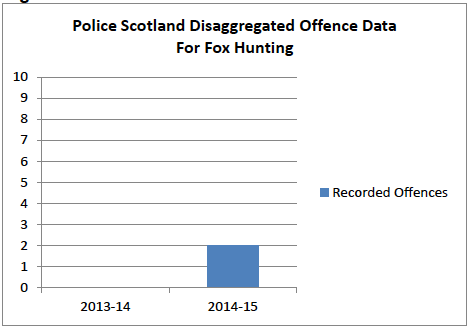
Source: Police Scotland
Prosecutions
In last year's report, the small numbers of cases allowed COPFS to manually search through reports related to the 2002 Act. This has now been amended to show a rolling 5 year data set for consistency in the report - please see Table 20.
This indicates the number of cases reported containing a charge under Section 1 of the 2002 Act specifically in connection with allegations of the hunting of foxes with dogs, and their outcomes. As noted earlier in the report, data from COPFS cannot be directly compared to court proceedings statistics in Tables 4 and 6.
Table 20: Cases Reported to COPFS involving fox hunting allegations, 2010-11 to 2014-15
| Year |
Total cases reported |
Cases marked no action** |
Prosecutions discontinued ** |
Prosecutions resulting in an acquittal |
Prosecutions resulting in a conviction |
|---|---|---|---|---|---|
| 2010-11 |
1 |
1 |
|||
| 2011-12 |
|||||
| 2012-13 |
|||||
| 2013-14 |
1* |
1* |
|||
| 2014-15 |
|||||
| Total |
2 (1*) |
1* |
1 |
Source: Crown Office and Procurator Fiscal Service
*Figures marked * indicate the number of cases in which the activity appears to have been associated with the activities of a mounted fox hunt.
**The basis for marking cases no action or discontinuing cases was that the evidence was insufficient in law to permit further action.
No cases were reported under the 2002 Act in the financial year 2014-15.
However, Liam Smith was reported for an offence under section 19(2) of the Animal Health and Welfare (Scotland) Act 2006 of causing a fox unnecessary suffering and having trapped it in a snare, placing it in a bag and releasing it to waiting dogs that pursued and killed it. He pleaded guilty and on 3 November 2015 he was sentenced to a community payback order with a requirement to carry out 130 hours unpaid work. He was also disqualified from owning or keeping any dog for 5 years.
Review of the Protection of Wild Mammals (Scotland) Act 2002
On 26 December 2015, the Minister for Environment, Climate Change and Land Reform, Dr Aileen McLeod, announced that the Right Hon Lord Bonomy would lead a review into the operation of the Protection of Wild Mammals (Scotland) Act 2002. Written submissions were invited between 1 February and 31 March 2016.
League Against Cruel Sports
The review of the review was to consider whether the Protection of Wild Mammals (Scotland) Act 2002 provided sufficient protection for wild mammals, while at the same time allowing effective and humane control of wild mammals, such as foxes, where necessary. The review would not:
- consider whether predator control was necessary to protect livestock or wildlife
- take a view on any particular incident or allegation
- consider the operation of other wildlife legislation unless it had a direct bearing on the operation of the 2002 Act
- consider other types of predator or pest control.
Lord Bonomy's review was published on 21 November and has been submitted to Scottish Ministers for consideration.
4.9 Trapping and Snaring
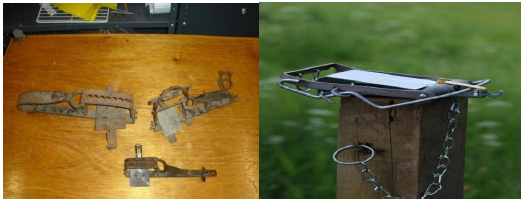
Illegal gin traps, Source © SASA, Crown Copyright
Legal fenn trap, set illegally as a pole trap © BASC
Trapping and snaring are methods which can be legitimately used for the control of some types of wildlife such as corvids, rodents or foxes. This may be for conservation purposes, to protect agricultural or sporting interests or for human health and safety reasons. However, the use of traps and snares is subject to legal restrictions designed to prevent harm to non-target species or unnecessary cruelty.
Recorded crimes
Trapping and snaring figures are not shown as part of the recorded crime statistics in Table 1 as the offence data cannot be broken down to that level. The new disaggregated data from Police Scotland in Table 15 shows that in 2013-14 there were 19 offences which rose to 27 in the following year. Figure 10 shows those Police Scotland figures for the period 2013-14 to 2014-15.
Figure 10: Police Scotland Disaggregated Offence Data for Trapping and Snaring
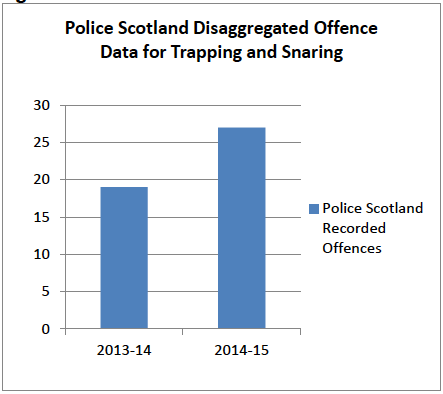
Source: Police Scotland
The Scottish SPCA identified 52 incidents relating to trapping or snaring offences which were investigated solely by its SIU inspectors.
Figures provided by SAC Consulting Veterinary Services provide some additional detail. In 2014-15, of the cases identified by SAC Consulting as suspected wildlife crime:
- 10 of 26 cases involving mammals, related to trapping or snaring.
- 2 of 30 cases involving birds, related to trapping.
Table 21 below shows the action taken in each of the 14 cases reported to COPFS in the period 2014-15. 50 per cent of those cases resulted in convictions. Of those 14 cases:
- 7 reports related to the use of traps.
- 7 reports related to the use of snares.
Table 21: Trapping and snaring related cases reported to COPFS, 2014-15
| No action |
Warning |
Acquitted or prosecution discontinued |
Conviction |
Total |
|
|---|---|---|---|---|---|
| Birds (non-raptor) |
1 |
1 |
|||
| Hares or rabbits |
|||||
| Raptors |
2 |
1* |
2 |
5 |
|
| Other |
1 |
2 |
5 |
8 |
|
| Total |
3 |
1 |
3 |
7 |
14 |
Source: Crown Office and Procurator Fiscal Service
* Note: This case also involved allegations of mammal trapping offences, but is not duplicated in the "Other" figure below.
Contact
There is a problem
Thanks for your feedback